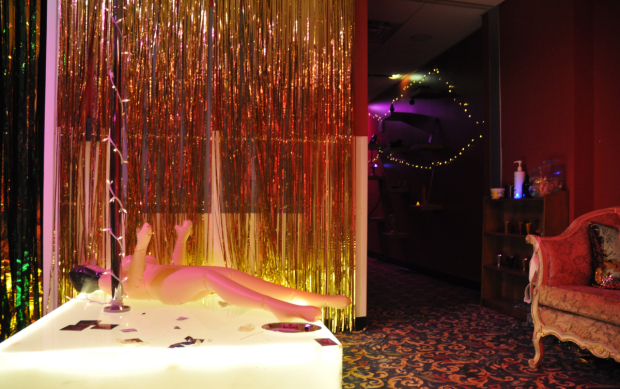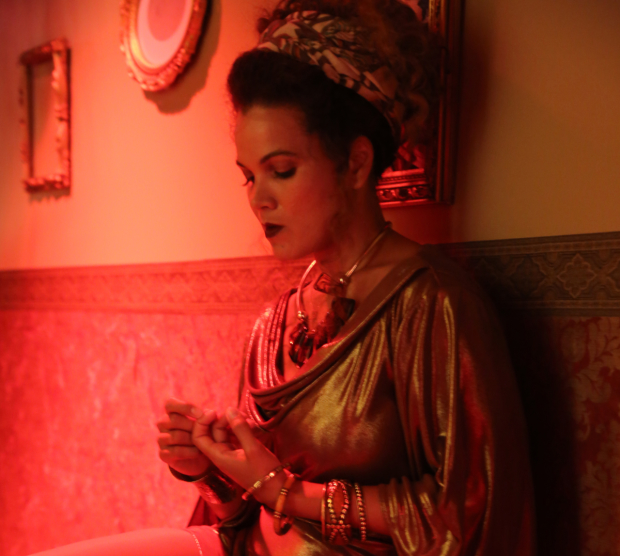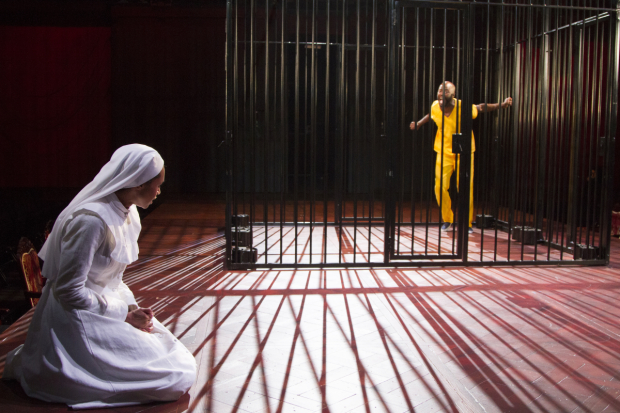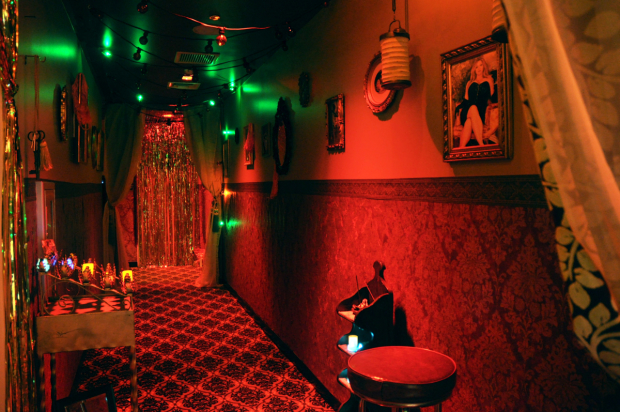Measure for Measure's Immersive Preshow Experience Is Making Shakespeare Sexy

(photo provided by Theatre for a New Audience)
The wall of sex toys is one memorable image for the patrons at Theatre for a New Audience's new Measure for Measure — but there's stiff competition. As patrons make their way to their seats, the colorful array of toys might be superseded by the raunchy wall hangings or the bass-underscored mid-act trysts as the employees and other lingering patrons start to come into focus in the dimly lit hallways of Brooklyn's Polonsky Shakespeare Center. The (optional) immersive ordeal forces audiences to get up close and personal in this greenroom-cum-modern brothel.
This multisensory preshow installation, reminiscent of Sleep No More, is created by director Simon Godwin and designer Paul Wills, and it marks their fifth collaboration. It's also the duo's third time partnering on a hyper-specific, modern take on Shakespeare (following Two Gentlemen of Verona and Hamlet at RSC), an aesthetic they initiated with their first two collaborations on the modern plays The Acid Test and Routes.
Godwin and Wills recently sat down in one of their space's red-lit rooms to explain what audiences can expect from the immersive elements of their show and why an erotically evocative walk to the theater is totally in keeping with Shakespeare's vision.

(photo provided by Theatre for a New Audience)
Why do the two of you keep coming back to Shakespeare?
Simon: To try to bring to the classics some of the experiences that I'd had doing new plays, making theater as urgent and engaging and relevant as I could, by treating Shakespeare as though it were a new play. So it seemed natural to invite Paul, who I had done new plays with to bring our aesthetic to Shakespeare.
Why Measure for Measure?
Simon: The play is essentially a dramatization of what happens when a right-wing ruler gets into power. And it is also a play about gender; which asks the question of where does a woman's voice fit into this highly patriarchal, right-wing universe? So it felt like a play well-suited to talk to people now. I was also interested in trying to see the play as not necessarily a pessimistic vision of human relations, but as a play that offers some kind of progress, a more nuanced and generous vision of how we might evolve as a community rather than as evidence of our failure as a community.
What was your process like?
Simon: For Measure for Measure, we knew that it was done originally at Shakespeare's Globe in 1604. The audiences would have passed by lots of brothels, because the theater was in the brothel district. So we wanted to say to the audience from the beginning, "You know that sex is getting out of hand," "You know what Angelo is trying to campaign against when he tries to close all the brothels down."
I must confess that I didn't actually go to a brothel, but we did a lot of research for references and images of what they might feel like. The journey is about taking a really real, true reference and then expanding it.
Paul: We also spent time sitting and reading through the play together scene by scene — understanding line by line and challenging each other as to the meaning of each scene and location to flesh out the worlds.
Simon: Shakespeare's language is written with a rhythm and a pulse and an intensity and an imagery system that's always trying to provoke you into collaborating psychologically and emotionally with the narrative.

(photo provided by Theatre for a New Audience)
How do you think setting the play in the modern day adds to the experience?
Paul: I think it helps a modern audience find immediate references that they can access and understand easier than in an environment that is slightly alien. And it's nice to recognize our world in the worlds that we create.
Simon: When Shakespeare did these plays originally, they were in modern dress. They didn't have period costumes, they just had the costumes of that day. Essentially he was saying these are new plays done in your costumes, your clothes, your voices, your language. So it feels more true to Shakespeare to put these plays in our language and our clothes.
Why give it immersive elements?
Paul: I think one of the keys for me at the beginning was to make it as immediate and immersive a production as possible, there's the smell of incense burning, there's textures, there's feelings that add another dimension to the experience.
Simon: In life, we're all looking for opportunities to go to sleep. And I mean that both spiritually and literally. So anything you can do to prevent people falling asleep is really a good thing. And the thing about theater is that it is a live experience, it is a wakeful experience. It is physical. It's human beings being with other human beings. So the more we increase that feeling, the more we intensify it, the more I think we're doing the plays justice. And anything that makes it easy to sleep, easy to be passive, easy to be switched off, is the enemy.

(photo provided by Theatre for a New Audience)











